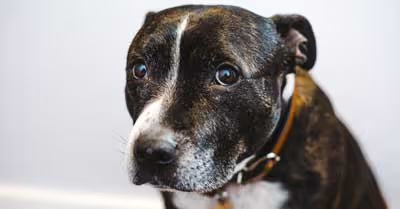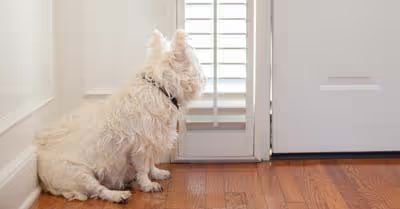Table of Contents
Reasons Why Chocolate is Bad for Dogs
It is true that many dog owners out there do not really realize the potential dangers that chocolate can pose to their lovely four-legged friends. Chocolate contains a chemical compound known as methylxanthines. These compounds contain theobromine and caffeine.
While theobromine and caffeine can make humans feel energized and euphoric, they are potentially deadly to dogs. Theobromine, which is the dark substance in chocolate, is the most toxic substance to dogs. Humans can naturally metabolize theobromine at a faster rate, which in turn renders its toxic properties not harmful.
On the contrary, dogs are unable to metabolize theobromine at a faster rate, thus making it very harmful to dogs. While theobromine is present in all types of chocolate including white, milk, and dark, it varies in levels. As such, your dog can be affected depending on the type and amount of chocolate he consumes.
The size of your dog may also be a factor. For example, the effects of chocolate may not be the same on a big dog as it would be on a small dog. Again, chocolate may not have much effect on your dog if it was on an empty stomach since it will be metabolized faster than if your dog was on a full stomach.
How do theobromine and caffeine affect dogs? Well, it all comes down to metabolism. Humans can easily metabolize theobromine and caffeine and that’s essentially why we can consume chocolate without needing any medical attention. The same cannot be said of our furry friends!
Dogs metabolize caffeine and theobromine slowly and consuming a huge amount of chocolate can build up in a dog’s system. This can then cause the dog’s muscles to relax while speeding up his heart rate and dilating the blood vessels. In essence, the chemical substances that are available in chocolate can seriously affect multiple organ systems in your dog.
You have to keep in mind that chocolate poisoning will mainly affect the central nervous system of your dog as well as its kidneys and heart. As you can see, these are serious issues and that’s why you should never allow your lovely dog to consume even the smallest amount of chocolate.
Different Types of Chocolate and How They May Affect Your Dog
Here’s a look at how different types of chocolate and how they may affect your dog.
White Chocolate (it contains 0.25mg per 28g) – This generally contains lower levels of theobromine since it’s typically made up of cocoa butter and not pure cocoa. Its effects on your dog may be much lower but this doesn’t make it safe for your dog and should be given to dogs.
Milk Chocolate (it contains 44-58mg per 28g) – This type of chocolate is made up of a mixture of milk, cocoa, and other ingredients. This means that it contains lower levels of diluted theobromine. But even with that, it can be a threat to your dog, especially if it’s of high quality. A square of such chocolate can cause serious health issues even to a middle-sized dog.
Dark/Plain Chocolate (it contains 130-450mg per 28g) - This type of chocolate contains the highest levels of cocoa and, of course, theobromine. It generally contains about 70% of theobromine depending on the quality and a small portion can cause serious health issues to your dog.
In addition to chocolate, any cocoa product including cocoa powder for baking, drinking cocoa, drinking chocolate, cocoa icing, and cocoa buttercream can cause serious health issues to your dog. They fall into the “do not give dogs” category and even a small piece can cause acute health problems to your dog.
Signs that Your Dog has Eaten Chocolate
In most cases, a dog will have diarrhea or vomit after eating chocolate. Your dog may also start acting as if he drank a pot of coffee. Well, theobromine and caffeine are stimulants and you shouldn’t be surprised if your lovely pooch starts zipping around animatedly.
The worst sign that your dog ate chocolate is increased heartbeats in your dog. Of course, this can lead to seizures and may become fatal. They can have a cardiac arrest and may cause death but such cases are very extreme and rare. Generally, your dog should have a stomach upset and nothing more than that unless he consumed an excessive amount of chocolate.
Another noteworthy sign that your dog might have after consuming chocolate is taking time to show up. The idea here is that theobromine might cause your dog’s muscles to relax and he may become lethargic.
You also have to keep in mind that dogs can slowly metabolize the compounds in chocolate, so the symptoms of chocolate poisoning may not show up until several hours later or even days. With that in mind, here are a few signs to look for.
- Vomiting
- Diarrhea
- Bloated stomach
- Hyperactive behavior
- Increased thirst
- Restless and pacing behavior
- Tremors and shaking
- Weakness and sluggishness
- Increased urination
- Heavy and rapid breathing
- Rapid heart rate
How Much Chocolate is Toxic to Your Dog?
While the weight of the dog and the amount of chocolate consumed can affect how badly your dog is affected by chocolate poisoning, it’s not advisable to give your dog even the smallest quantity of chocolate. But scientifically speaking and to set the record straight, the higher the amount of theobromine, the more dangerous the chocolate will be for your lovely dog.
As such, it’s right to note that the darker the chocolate, the more toxic it is for your dog. So theobromine in the region of 100-150mg per kg of your dog’s body weight can be poisonous. Here’s an example. If your dog weighs 10kg, consuming chocolate with a theobromine quantity of about 1,000mg could be deadly.
This can be equal to just a single piece of a chocolate bar. As a dog owner, you shouldn’t take chances. You don’t have to go through the stresses of having to know the amount of chocolate that your dog should or shouldn’t eat. The best thing to do is to prevent your dog from eating chocolate altogether. After all, prevention is much better than cure.
The general rule is that any amount of chocolate is bad for your dog. Again, the better quality of chocolate the higher content of theobromine and the more likely dangerous it will be for your pooch.
What to Do if Your Dog Eats Chocolate
One of the most important things to do if you’ve discovered that your lovely dog has eaten chocolate is not to panic! You have to stay calm and remember that all is not lost. You, however, have to act quickly so that your dog can be helped.
Here are a few things to do.
Seek Veterinary Attention Immediately
While there are a few home remedies to consider, the first thing to do when you realize that your dog ate chocolate is to call your vet immediately. With the help of your vet, you’ll be able to assess what type and how much chocolate your dog ate.
Having as much information as you possibly can on the amount of chocolate that your dog consumed can be integral in saving your dog. This is one of the first things that your vet will ask you as it allows him/her to give their best care. You should keep the chocolate wrapper on hand so that the vet can tell what kind of chocolate and the amount your dog consumed.
By knowing the amount and type of chocolate that your dog has consumed, your vet will know what to do. He/she will advise you on what to do or whether you should take the dog into their office. Of course, he’ll have to check the type of chocolate and the amount consumed as well as the weight of your pup. He’ll then let you know if the dog needs emergency medical attention or just a simple telling off.
Keep in mind that your vet not only has the skills but also the staff, drugs, and equipment needed to treat chocolate poisoning in dogs. He/she has drugs that can be used to induce vomiting, especially if your dog ate chocolate within an hour or so. This is essential in flushing the chocolate substances out of your dog’s system.
If the case is extreme, your vet may choose to hospitalize your dog for 24 hours so that he/she can monitor him closely. You also have to remember that chocolate poisoning does not necessarily happen during office hours and your vet may be unavailable. Under such circumstances, you can seek alternatives such as clinics that specialize in medical emergencies.
Home Remedies
While there are no scientific proofs that home remedies are either safe or will successfully treat your dog if he ate chocolate, some have been known to work. Let’s go through them.
Inducing Vomiting Using a Diluted Hydrogen Peroxide
Flushing the chocolate compounds out of your dog’s system can be an important step in treating your lovely pooch of chocolate poisoning. Many experts and researchers advocate the use of a teaspoonful of hydrogen peroxide with water to induce vomiting. Well, this may work, but you shouldn’t induce any form of vomiting if not advised to do so by your vet.
You should only use hydrogen peroxide if advised by your vet and if your dog ingested chocolate in the last hour or so. You have to make sure that there are no neurological tremors just yet and that there might be fatal complications if you try making your dog vomit without following the vet’s advice.
Your vet will recommend that you use a solution of water and 3% hydrogen peroxide in equal amounts. You have to make sure that you give your dog the right dosage, which is usually a teaspoonful of the diluted hydrogen peroxide for every ten pounds of your dog’s body weight.
Using Ipecac
Your vet may also advise you to give your dog the ipecac syrup as a way of inducing vomiting. Just like when using hydrogen peroxide, it should be administered an hour or so after your dog ate chocolate. Similarly, the right amount of dosage should depend on your dog’s body weight.
In most cases, a quarter of a teaspoon of ipecac will be enough to induce vomiting in a normal-sized dog. You have to wait for about 15 to 20 minutes for your dog to begin throwing up. If it doesn’t vomit after 20 minutes of the first dose, you can administer another dose and wait.
You shouldn’t, however, administer the third dose if he doesn’t throw up after the second dose. Instead, take your dog to the vet clinic for further examination. You have to remember that giving your dog more hydrogen peroxide or ipecac can be as deadly as your dog eating chocolate. This is because hydrogen peroxide and ipecac are caustic and can cause major problems in your dog’s stomach and esophagus.
Administer Activated Charcoal
Making your dog vomit after eating chocolate will most probably remove huge chunks of chocolate from his stomach. However, the deadly substances have probably entered his bloodstream, especially if the chocolate has been in his stomach for too long.
So once your dog has finished throwing up, you can consider administering activated charcoal. This should, however, be done as the last resort and only if your vet permits it. Activated charcoal can bind theobromine, thereby making it pass through your pup’s system without causing any issues.
In other words, it can help in preventing theobromine, as well as other toxic elements of chocolate, from getting absorbed in your dog’s intestines and system.
The right dosage should be 1 gram of charcoal powder to be mixed with 1 teaspoonful of water per 1kg or 2.2 pounds of the dog’s body weight. You also have to keep in mind that smaller dogs will be fine with one teaspoon while a bigger dog may need 2 teaspoons.
Warnings about Using Activated Charcoal
As noted earlier, activated charcoal should be used as a last-ditch effort after all other home remedies have been tried and aren’t working. In other words, it shouldn’t be your first option and should never be administered without a recommendation from your vet. It would even be ideal if it’s administered by the vet.
You shouldn’t administer activated charcoal to your dog if he’s throwing up, having tremors, or seizures. Activated charcoal can be fatal if it gets into the dog’s lungs, so you should avoid this.
In addition to being careful when administering activated charcoal as it can cause stains in various parts of your house, getting the charcoal into the dog’s stomach can be quite challenging. You may require a tube or syringe to administer the activated charcoal. You can as well consider mixing the activated charcoal with a little food, though this isn’t recommended as it may worsen the situation by getting charcoal to the lungs.
There may be side effects such as black stool and constipation. Another side effect is that it can enhance sodium levels in his bloodstream and this can cause tremors and seizures.
Activated charcoal can be toxic if administered inappropriately. You should also avoid using activated charcoal repeatedly as it can cause dehydration, diarrhea, and other serious complications.
How to Prevent Your Dog from Eating Chocolate
Even though we’ve gone through a few things that you can do if your dog ate chocolate, it’s of great importance to note that your chocolate can be deadly to your dogs and he shouldn’t have access to it or eat it in the first place. So instead of having to undergo the stress of having to treat your dog after eating chocolate, you can prevent this from happening altogether.
We all know that the smell of chocolate can be tempting even to your dog but the following tips should help ensure that your dog doesn’t eat chocolate.
Lock the Chocolate Away – Whether it’s kept in a chocolate bar, behind, or high up the cupboard, make sure that your lovely pooch doesn’t have any access to chocolate. It doesn’t matter whether you’re home or not, make sure that your dog is well-trained to stay off the kitchen surfaces.
And even if they become crafty and have ways of trying to access chocolate, make sure that the chocolate is safely locked away.
Remind everyone in the household including the guests – When it comes to training your dog, it’s always a good idea that everybody within the household is on the same page as far as what should be done and what shouldn’t be done are concerned.
It wouldn’t make much sense if some members are responsible enough not to give the family dog chocolate while others offer him chocolate. That being said, it’s essential to ensure that everybody in the household including guests is reminded not to intentionally or unintentionally give chocolate to the dog as this can be very harmful.
Secure your bins – We all know that a dog won’t hesitate when it comes to rummaging through your bins for leftovers. The best thing to do is to ensure that all the unwanted chocolates are disposed of in the bins and the bins are perfectly secured so that they become inaccessible to your dog even when knocked over.
Be more vigilant during holidays and celebrations – Chocolate boxes and wraps can indeed be easily left lying around during holidays. This can make them easily accessible to your dog and the repercussions can be fatal.
The best thing to do is to become extra careful to put anything edible that might be lying around in its right place. Securing the remnant in the bin, especially during Christmas, Easter, and thanksgiving will reduce the chances of your dog accessing chocolate.
Other Toxic Food that You Shouldn’t Give Your Dog
You should keep in mind that chocolate isn’t the only human edible food that’s dangerous to our four-legged friends. Here are a few foodstuffs that may be fatal to your dog.
- Corns on the cob
- Onions, garlic, and chives
- Macadamia nuts
- Grapes and raisins
- Xylitol (an artificial sweetener generally found in peanut butter)
- Cinnamon
- Ice cream
- Walnuts
- Almonds
- Cashews
The dangers of cocoa and chocolate to dogs are often overlooked. While you may think that giving your lovely dog chocolate is a nice way of treating him, it can potentially harm your dog and even cause death! As such, you should always avoid giving your dog chocolate or any of the above-mentioned foodstuffs.
But if by bad luck, your dog eats chocolate, you should call your vet immediately. Do not assume it as it could become disastrous and you may end up losing your lovely dog.
Recent Articles














